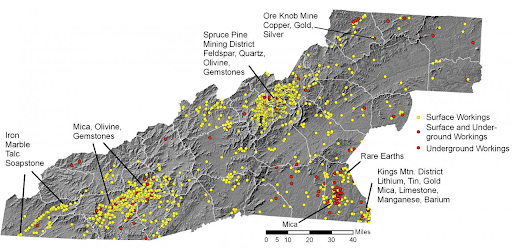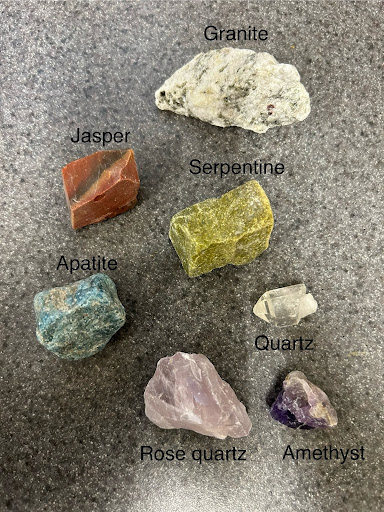WNC and the Appalachians in general are known for their bountiful and high-quality mineral resources. Some of the most well-known North Carolinian geologic resources include the state rock, granite, used in construction and paving, and the state gemstone, emerald, used in jewelry. Some other notable Appalachian resources include:
Feldspar: Feldspar lowers vitrifying temperatures as a flux in glass and ceramics. It is the most abundant mineral in the earth’s crust. Feldspar was first mined in Spruce Pine, NC in 1911 and is still a major industrial mineral for the state today.
Talc: Talc deposits occur along the Murphy belt in North Carolina. Talc is a highly versatile soft mineral used in ceramics, paint, paper, cosmetics, and textiles. It shrinks upon firing and adds strength to pottery and adds whiteness, absorbs oil, and increases chemical inertness and viscosity in paints. Most talc mines were in Virginia and are now inactive. Pyrophyllite, a similar mineral used in ceramics, is still mined in Moore County, NC.
Mica: North Carolina accounts for 60% of U.S. scrap mica production. Alongside mica’s primary uses in electrical insulation and cement, mica has also been used in cosmetics as face powders and eyeshadows and paint pigments.
Kaolin: Kaolin is mined as a byproduct of feldspar and mica in Avery and Cleveland, NC. Georgia accounts for 90% of U.S. Kaolin Production. It is used in ceramics, paint, and paper coating.
Ball Clay: Tennessee is the leading producer of ball clay in the U.S. Ball clay is a fine-grained kaolinitic clay used in electrical porcelain, fine china, and pottery, increasing strength and workability. It is typically mined from open pits.
Copper: Copper was mined in sulfide deposits in Ashe, Jackson, Macon, Swain, and Watauga, NC. It is not significant to the state’s mining industry today. The Copper Basin in southeastern Tennessee was also a major region for copper mining until 1987. The Cherokee utilized copper in this area to make jewelry and tools using a cold-hammer method.
Corundum: Macon County, NC produces high-grade rubies and sapphires. It is commonly found in metamorphic environments. Its extreme hardness makes it well suited for gemstones and jewelry.
Iron Oxides: Iron oxides, typically mined from magnetite or hematite reserves, can be used to make red, black, and brown paint pigments. They are currently mined in Virginia, Georgia, and Alabama. The Cherokee likely mined iron oxides at Cranberry Iron Mine in Avery County, NC before it became a mine for weapons production for the confederacy in 1826.

A map of WNC's mineral resources

Assorted hand samples from Crabtree Emerald Mine
Made by the Pet Rocks: Sam, Olivia, Angie, George, and Zach. ENVR 282.